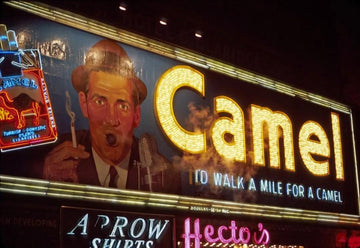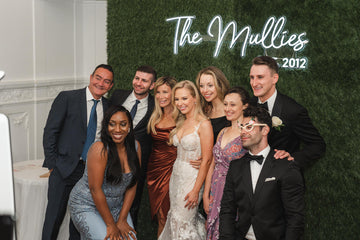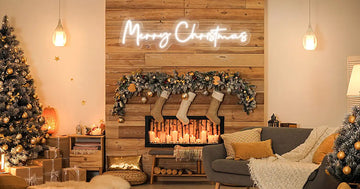News
History Of Neon: The Good, the Bad, and the Future
by LWilliam
on
Oct 20, 2022
Every era always has its own trend. When the next wave comes, they will gradually recede in the passage of time, or become the object of rejection in the new wave, end in a hurry, and almost disappear in the new era, but Therefore, they have become the unique style of their peerless period of time.
From the 1920s to the 1960s, it was the colorful neon lights that emerged on the turbulent streets of North America, sketching people's diverse nightlife.

An engineer who doesn't know chemistry is not a good neon inventor
In 1893, Gas-discharge lamps first appeared at World's Columbian Exposition, and Nikola Tesla personally demonstrated it, but he did not apply for a patent.
Neon was first discovered in 1898 by two British chemists, Sir William Ramsay and Morris W. Travers. Not long after, American electrical engineer Daniel McFarlan Moore brought the first gas-discharge lamps to the market, the nitrogen-made lamps that became the precursor to neon.
In 1910, neon made their debut at the Paris Motor Show. Its inventor, the French engineer Georges Claude, invented the neon by illuminating neon gas, a by-product of his own air liquefaction business, in a sealed tube.
In 1915, Claude obtained a patent for corrosion-resistant electrodes, which removed the last technical obstacle and started the road to industrialized mass production of neon.

+++ Neon lights in front of the Grand Palais in Paris©Léon Gimpel (1910/1912)
At the beginning, Claude only regarded neon lights as ordinary indoor and outdoor lighting, and his partner Jacques Fonseque took a fancy to its application potential in the advertising industry. Sure enough, neon signs were very popular as advertising signs. People like its psychedelic lights and diverse text and graphics, and merchants are willing to buy this novelty sign at a high price. Neon gradually became popular in Europe, and Claude also began to expand his business empire to other corners of the world.
+++ Large, striking neon sign in place Blanche ©Léon Gimpel (1929)

The colorful in the dark night is the one that client wants
In 1923, Los Angeles car dealer Earl C. Anthony bought two "Packard" signs from Claude's company, and neon began to successfully enter the United States, and more colors were developed. Neon first became a symbol of car culture, dotting highway fast food restaurants, gas stations and motels at night, and then lighting up city bars after Prohibition was lifted. Times Square in New York is also famous for its neon signs.
Since the popularity of neon lights, there have been many small workshops infringing on the manufacture. After the patent expired in 1932, the craftsmen became more reckless, and Claude's business was hit hard until the designer Douglas Leigh joined. He combined bold and creative signs and lighting designs with neon lights for a moment.
+++ New York Times Square in the 1930s on a postcard©Flickr
+++ The "Camel man" signboard in Times Square combines the signboard with smell, sound and mist, making the man on the signboard breathable and eye-catching.©Unknown
In the 1940s and 1950s, Las Vegas became the epitome of neon culture, with garish colors, patterns, and lighting dynamics tightly integrated with architecture that filled the streets. Unlike Douglas Leigh's concept of signboards as landscaping, Las Vegas-specific culture makes the signboard itself a spectacular spectacle.
+++ Neon Museum in Las Vegas(The Neon Museum)©Deidra Wilson
Canada, also located in North America, also experienced neon fever. As Canada's "neon capital", Vancouver's number of lights reached its peak in the 1950s, with nearly 20,000 lights scattered all over the neighborhood, with an average of one for every 18 residents, second only to Las Vegas in total. Going to the street to watch neon even became a pastime for people at the time.
+++ Pender Street, Chinatown, Vancouver, 1960s©Archive Photos/Getty Images

Tacky or popular? Who has the final say?
After reaching its heyday in the 50s, neon began to decline. Bright colors often associate it with the red light district, public aesthetics have changed, and cities have begun to promulgate anti-neon laws.
In 1958, Vancouver's Community Arts Council asked City Hall to renovate the city's appearance, arguing that tacky neon were not worthy of the city's proud natural beauty and should not be allowed to tarnish the city's reputation.
"What kind of face do we want to show the world? If we insist on this very noisy and shiny appearance, how do we introduce ourselves? Where is our dignity?"
+++ San Francisco's North Beach is also known as the red light district©Starcity
In 1974, new sign regulations were introduced, which imposed various strict restrictions on neon. Existing lights were spared, but once repaired and reinstalled, they had to comply with the new regulations. This greatly affected the development of neon, and now only a few neon have survived, some of which are left on the streets, and some of them have entered the city museum.
+++ Granville Street in downtown Vancouver is covered with dense neon lights and was called "the city that never sleeps" in 1965.(Great White Way)”©George Weinhaupl
The number of neon signs in the United States also declined rapidly in the 1960s. Fluorescent and plastic signs have become the new favorites due to their low prices, lower maintenance costs and savings on electricity bills, neon is out.
The controversy over neon isn't just about aesthetics, it's also about light pollution. Does the flashing light affect the rest of the surrounding residents? Does a cloudy city with long nights need more light? These questions are inconclusive, but they are worth thinking about.














